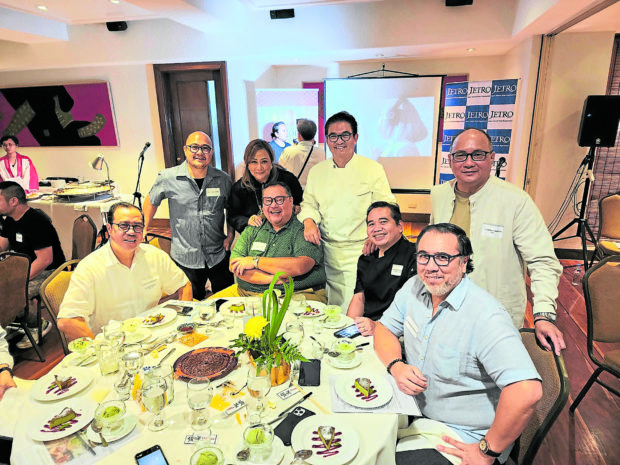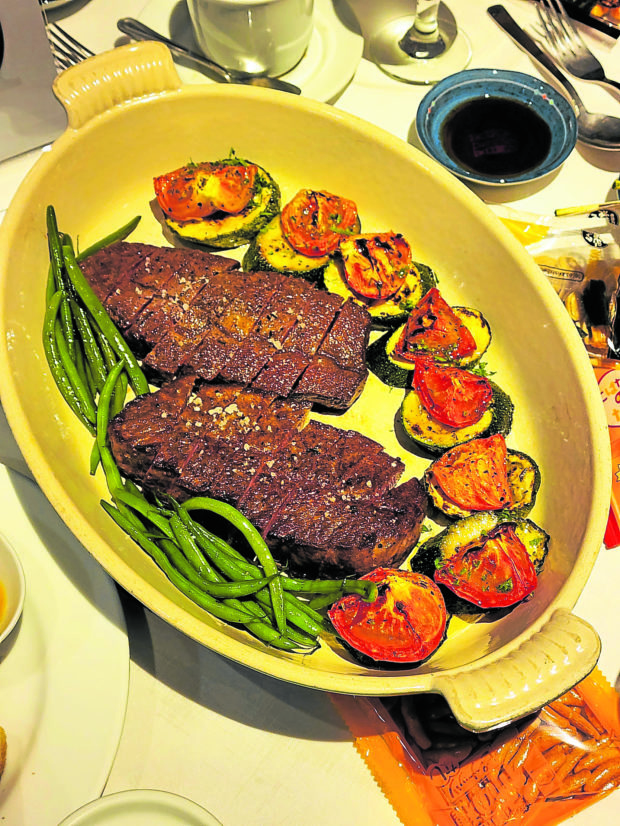Japanese culinary showdown

What was perhaps “the” culinary event of the year just transpired on Friday. Held at the MilkyWay Cafe, “Savor the Versatility of Japanese Ingredients” was an event so well attended by the country’s culinary greats. I couldn’t recall a time when as many kitchen superstars were gathered together in a room. It was a happy and tasty day as Cirkulo’s chef J Gamboa and Tsukiji’s chef Okajima showcased nine premium ingredients from Japan.
Two menus were prepared for that day, using the same ingredients but prepared different ways, in two totally distinct cooking styles.
The gentlemen began by examining each ingredient and thought of ways to use them in Western cuisine. The idea was not to make it too complicated to prepare and easy for guests to appreciate.
Chef J came up with this menu: Hamachi, cured gravlax style; Scallops Gratin; Madai Seabream in Salt Crust; Roast Wagyu Beef; Wagyu Chuletón; Akitakomachi Rice Paella with Baby Squid, Scallops, Spinach; and Baked Matcha Basque Cheesecake.
Then, Chef Okajima went on to create his own Japanese menu: Assorted Sashimi (Hamachi, Madai, Hotate and Salmon Negi–Cream Cheese); Tempura of Scallop with Matcha Sea Salt; Madai Nitzuke (Braised Seabream with soy sauce and ginger); Wagyu Sukiyaki with Sendai A5 wagyu shoulder clod; Karubi Soup with Sendai Wagyu gooseneck round; Takana Rice (pickled mustard fried Koshihikari rice) and Green Tea Ice Cream.

It was an elaborate tasting, though simple on the palate. The skills of both chefs were evident. The ability to bring out the best in an ingredient requires skill, and both chefs showed such mastery of their craft.
Two menus side by side, using the same main ingredient, but in totally different cooking styles. Indeed, no dull moment for the tastebuds.
Chef J pointed out how they were both impressed by the versatility of Japanese ingredients.The event was organized by the Japan External Trade Organization in the Philippines and the Japan Food Product Overseas Promotion Center, along with nine featured Hightower premium products.
Sendai Beef is an award-winning Wagyu from the capital of Tohoku. On that day, most of the beef dishes served were prepared using lesser known cuts, such as the gooseneck round and shoulder clod. All tasted good. I loved the chuletón, particularly.
Zao Cream Cheese is natural cheese, made in the foothills of Mt. Zao, known for its silky-smooth, melt-in-your-mouth consistency. This sublime cream cheese was made into a green tea Basque style cheesecake by Chef J and a Salmon Negi–Cream Cheese maki by Chef Okajima.
Rice
Gohan, Japanese for rice, means “an entire meal”; such is the importance of this grain to the Japanese. To them, it is their everything, which is why so much care is put into its production.
Usually grown in March, blooming in August and harvested between September and October, rice varieties are aplenty. I had a sampling of an excellent grain that was round and soft but kept its shape. Koshihikari is excellent rice—it is sweet, chewy and sticky. Should you come across Koshihikari, don’t forget to store it in an airtight container in the fridge to maintain its freshness.

Last Friday, the rice was tossed in soy and pickled mustard to make Takana Fried Rice. It was so, so good. Chef J put his paella making skills to work and served a large paella laden with juicy, plump Japanese scallops, baby squid and spinach.
For the sushi assortment, Chef Okajima used Akitakomachi, a less sticky type of rice that keeps its character even if cold, making it an excellent choice for sushi and bento boxes.
When hamachi (Japanese amberjack), known for its soft and tender flesh, matures, it is known as kurose buri, which is firmer, more flavorful and has a distinct flavor. The hamachi was served as sushi and ceviche.
The ainan madai, the red sea bream, was for me the star of the show. The flesh was ultra soft and sweet. Well, that Chef J salt crusted it of course contributed to it being moist and even juicier. The Japanese way was as sushi and braised in soy and ginger. It was equally delicious. The fish was flown in fresh.
The Hokkaido scallops with white wine, cream cheese sauce and angel hair was divine. As was the scallop tempura—it was soft and succulent, and not at all rubbery.
Then there was free-flowing premium sake. My favorite was the Red Label Mutsu Hassen Tokubetsu Junmai, dry with hints of apple, peach and pineapple.
It was by all means an affair to remember—a meal partaken of by friends bonded by a shared passion for good food.
Have a taste of that day with these recipes shared by Chef J and Chef Okajima.
Cirkulo’s Paella de Calamares, Vieras y Espinacas (Saffron Seasoned Rice with Baby Squid, Scallops, Spinach, Radish Sprouts)
3-4 c fish stock
Pinch of saffron
2 Tbsp olive oil
2 Tbsp onion, diced
1 tsp garlic, minced
1 Tbsp tomato, diced
200 g baby squid, cleaned
½ tsp Pimenton de la Vera
Salt and pepper to taste
1 c Japanese rice
2 Tbsp white wine
200 g spinach
100 g Hokkaido scallops, sliced horizontally
1 bunch radish sprouts
Lemon juice, as needed
Extra virgin olive oil, as needed
Chopped parsley, as needed
In a saucepan, bring fish stock to a boil. Turn off heat, allow to cool for 10 minutes, then add the saffron to steep.
In a paellera or sauté pan, heat olive oil, sauté onion, garlic and tomato. Add baby squid, combine with mixture. Season with Pimenton de la Vera, salt and pepper.
Add rice, mix well. Deglaze pan with white wine. Gradually add fish stock with saffron and bring mixture to a boil.
Reduce heat to a simmer. When slightly thickened, add spinach and combine well.
Cover paellera with aluminum foil and cook for 12 minutes until rice is done.
Remove foil and arrange seasoned (salt and pepper) scallops on top of paella and cover for 1-2 minutes to heat through.
In a bowl, toss radish sprouts with olive oil and lemon juice, season with salt and pepper.
Garnish paella with seasoned sprouts, chopped parsley and olive oil.
Serves 3.
Tsukiji Madai Nitzuke (Braised Sea Bream)
1 kg Madai sea bream or a white fish (lapu-lapu or maya-maya) cut into 6 pieces
1 c sake
6 Tbsp mirin
3 Tbsp sugar
6 Tbsp Japanese soy sauce
6 slices ginger
In a wide saucepan or wok, combine sake, mirin, sugar and soy sauce and bring to a boil.
Reduce heat to a simmer then carefully place the fish in the sauce together with the ginger slices. Simmer covered for 8-12 minutes until fish is cooked, basting from time to time. If the sauce is too thick, add a little water. Turn off heat and let sit in sauce for at least 30 minutes before serving.
Follow the author @iamreggieaspiras on Instagram and Facebook; reggieaspiras.com
For all the latest Lifestyle News Click Here
For the latest news and updates, follow us on Google News.

